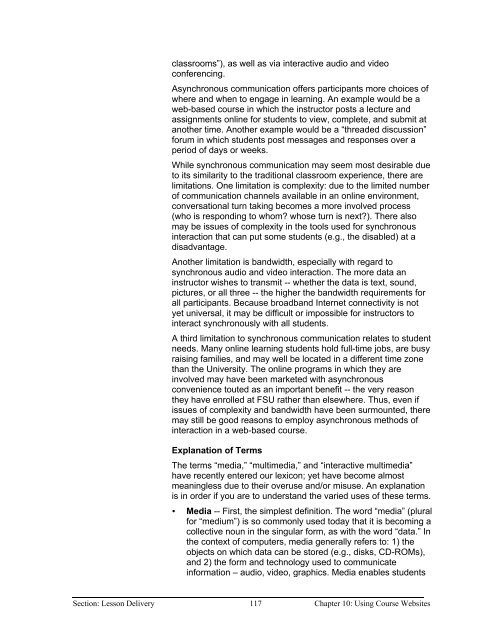Chapter 9 - Instructional Media: Chalkboards to Video - CGISS
Chapter 9 - Instructional Media: Chalkboards to Video - CGISS
Chapter 9 - Instructional Media: Chalkboards to Video - CGISS
You also want an ePaper? Increase the reach of your titles
YUMPU automatically turns print PDFs into web optimized ePapers that Google loves.
classrooms”), as well as via interactive audio and video<br />
conferencing.<br />
Asynchronous communication offers participants more choices of<br />
where and when <strong>to</strong> engage in learning. An example would be a<br />
web-based course in which the instruc<strong>to</strong>r posts a lecture and<br />
assignments online for students <strong>to</strong> view, complete, and submit at<br />
another time. Another example would be a “threaded discussion”<br />
forum in which students post messages and responses over a<br />
period of days or weeks.<br />
While synchronous communication may seem most desirable due<br />
<strong>to</strong> its similarity <strong>to</strong> the traditional classroom experience, there are<br />
limitations. One limitation is complexity: due <strong>to</strong> the limited number<br />
of communication channels available in an online environment,<br />
conversational turn taking becomes a more involved process<br />
(who is responding <strong>to</strong> whom whose turn is next). There also<br />
may be issues of complexity in the <strong>to</strong>ols used for synchronous<br />
interaction that can put some students (e.g., the disabled) at a<br />
disadvantage.<br />
Another limitation is bandwidth, especially with regard <strong>to</strong><br />
synchronous audio and video interaction. The more data an<br />
instruc<strong>to</strong>r wishes <strong>to</strong> transmit -- whether the data is text, sound,<br />
pictures, or all three -- the higher the bandwidth requirements for<br />
all participants. Because broadband Internet connectivity is not<br />
yet universal, it may be difficult or impossible for instruc<strong>to</strong>rs <strong>to</strong><br />
interact synchronously with all students.<br />
A third limitation <strong>to</strong> synchronous communication relates <strong>to</strong> student<br />
needs. Many online learning students hold full-time jobs, are busy<br />
raising families, and may well be located in a different time zone<br />
than the University. The online programs in which they are<br />
involved may have been marketed with asynchronous<br />
convenience <strong>to</strong>uted as an important benefit -- the very reason<br />
they have enrolled at FSU rather than elsewhere. Thus, even if<br />
issues of complexity and bandwidth have been surmounted, there<br />
may still be good reasons <strong>to</strong> employ asynchronous methods of<br />
interaction in a web-based course.<br />
Explanation of Terms<br />
The terms “media,” “multimedia,” and “interactive multimedia”<br />
have recently entered our lexicon; yet have become almost<br />
meaningless due <strong>to</strong> their overuse and/or misuse. An explanation<br />
is in order if you are <strong>to</strong> understand the varied uses of these terms.<br />
• <strong>Media</strong> -- First, the simplest definition. The word “media” (plural<br />
for “medium”) is so commonly used <strong>to</strong>day that it is becoming a<br />
collective noun in the singular form, as with the word “data.” In<br />
the context of computers, media generally refers <strong>to</strong>: 1) the<br />
objects on which data can be s<strong>to</strong>red (e.g., disks, CD-ROMs),<br />
and 2) the form and technology used <strong>to</strong> communicate<br />
information – audio, video, graphics. <strong>Media</strong> enables students<br />
<strong>to</strong> reread lectures, which they may have missed in class while<br />
taking notes.<br />
Section: Lesson Delivery 117 <strong>Chapter</strong> 10: Using Course Websites
















